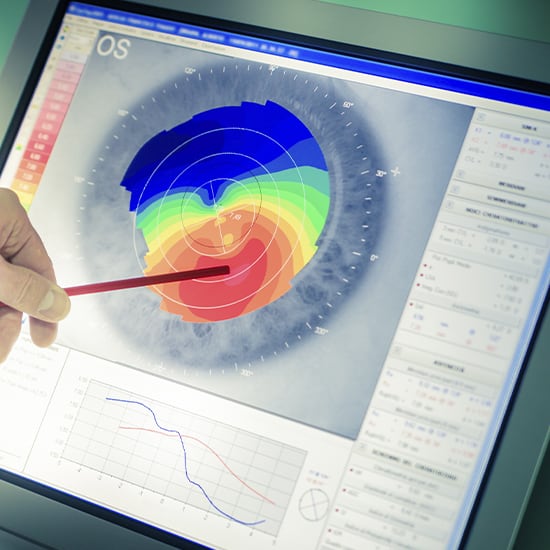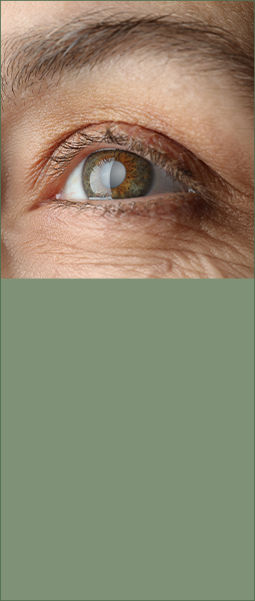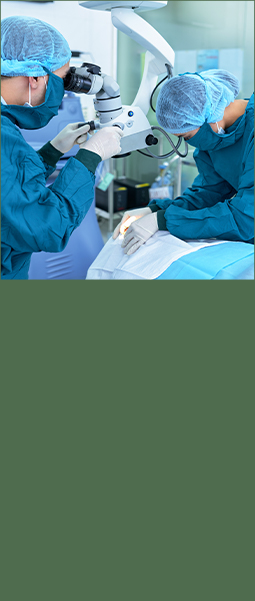Innovating Care through Technology
When it comes to giving our patients a thorough eye exam, diagnosis, or eye treatment, our technology is a vital part of our services. Not only does it help increase our efficiency, but it helps us better understand your vision and health.
Our technology comes into play for almost all of our services, including laser eye surgery consultations, management and diagnosis of glaucoma, keratoconus, dry eye, and cataracts, as well as our comprehensive eye exams and contact lens fittings.
Learn more about the technology we use and the reason we use it by booking an appointment with Cherry Creek Eye today.
Book Appointment

Our Technological Approach
Technology is at the core of what we do. We feel that using modern industry devices and innovative technical tools helps us fully extend the support we offer for our patients.
Your eye health is important to us, and we want to be able to provide eye care that meets all your needs through every stage of treatment for eye conditions, including diagnosis, examination, analysis, and surgery when necessary.
Imaging Technology
Imaging technology is one of the most important factors in the diagnosis of eye diseases and conditions such as cataracts and glaucoma. This is because this technology allows us to get a close view of many parts of the eye as well as monitor changes over appointments.
The imaging technology we utilize at Cherry Creek Eye includes ultra-widefield imaging, OCT scans, Humphrey visual field testing, testing with iTrace, and meibography.
Optos Ultra-Widefield Testing
The Optos ultra-widefield imaging camera facilitates precise photography of the retina at the back of the eye.
With this camera, we can see and analyze about 200 degrees (80%) of the retina. This view of your eyes can be invaluable for the early diagnosis of retinal diseases.
Optical Coherence Tomography (OCT)
Optical coherence tomography (OCT) involves taking cross-sectional images of the retina. This imaging technology uses light waves to take these cross-sectional pictures, which allows us to view the layers of the retina and retinal thickness to look for abnormalities and specific conditions.
Humphrey Visual Field Testing
The Humphrey visual field test examines visual field loss. Your visual field is the extent of what you can see around your central vision—also referred to as peripheral vision. This test uses a light stimulus to help us assess the extent and capabilities of your full visual field and spot conditions that can affect peripheral vision, like glaucoma.
iTrace
The iTrace is a corneal topography and wavefront aberrometry device. It scans your cornea’s curvature and checks for corneal abnormalities. This device can separate the performance of your eye’s lens and cornea to help us fully understand what you see.
Understanding the shape of your cornea can be especially helpful with fitting contacts for people affected by corneal irregularities related to conditions like keratoconus.
This device also helps us to understand how much cataracts may be affecting your vision and help determine when cataract surgery should be recommended. It also gives us information about which intraocular lenses would be most beneficial to correcting your vision during cataract surgery as well.
Meibography
Meibography assesses your meibomian glands—the glands on the inside portion of the eyelid that produce oil to support your tear film. When these glands are damaged and meibomian gland dysfunction occurs, you may experience several dry eye symptoms.
Meibography allows us to assess meibomian gland function and recognize changes over time to help us treat and prevent dry eye symptoms.
Eaglet-Eye Profilometer
The Eaglet-Eye Profilometer takes up to 350,000 measurement points over a 20mm area of the front of the cornea, limbus, and sclera, to produce highly accurate 3D maps that assist in the design of a wide variety of contact lenses; including scleral, hybrid, and orktho-K designs allowing for a better fitting lens, faster.
OptiLIGHT by Lumenis for Dry Eye
OptiLIGHT by Lumenis is a light-based, noninvasive treatment done in the area below the eyes to manage dry eye. The first and only IPL FDA-approved for dry eye management.
The treatment is safe, gentle, and is backed by more than 20 clinical studies.
OptiLIGHT uses precise pulses of light to reduce the inflammation that is typically associated with dry eye disease, improve tear break-up time, and increase meibomian gland functionality.
Other Technology
Beyond imaging technology, we rely on other technological devices that give us a wide range of different measurements, readings, and information related to your eye health. These devices help us with disease diagnosis and management as well as planning and consultations for some surgical procedures.
The other technology we use includes the iCare tonometer, the Eaglet-Eye profilometer, the IOLMaster 700, the Light Adjustable Lens device, autorefraction and auto-keratometry devices.
iCare Tonometer
The iCare tonometer allows us to measure the intraocular pressure of the eye without the use of eye drops or a puff of air. This device is especially helpful for glaucoma diagnosis and management.
IOLMaster 700
The IOLMaster® 700 from ZEISS gives us information about the curvatures on the front and back of the cornea along with measuring the length of the eye, and gives us information regarding things such as tilt or decentration of the crystalline lens. All of this information is used in calculating the power needed for the intraocular lens implant to be inserted during cataract surgery to give your desired visual outcome.
The Light Adjustable Lens by RxSight Device
The Light Adjustable Lens by RxSight is the first and only lens that can be adjusted and customized after cataract surgery.
During surgery, your natural lens is replaced with an adjustable intraocular lens. The difference with the adjustable lens is that after surgery, we can adjust the lens to fine-tune your vision based on your preferences.
The adjustable lens utilizes the Light Delivery Device for adjustments, which uses UV light to reshape the lens to your specific vision needs.
Autorefraction & Auto-Keratometry
Autorefraction is the term used for equipment that helps us detect refractive errors within the eye, such as myopia (nearsightedness), hyperopia (farsightedness), and astigmatism. Autorefractors are automated technology used to help diagnose these errors and determine a person’s prescription.
Auto-keratometry measures the cornea’s curvature and is an important test used for diagnosing astigmatism, and conditions like keratoconus, and fitting contact lenses.
Laser Technology
Laser technology is an important aspect in many of our glaucoma, cataract, and laser eye surgery treatments. Laser technology can help treat some eye conditions and correct vision, depending on the technology used.
We utilize the YAG laser, argon laser, and SLT laser and also provide laser eye surgery consultations at our practice.
While we perform our surgical procedures off-site, we also provide laser eye surgery consultations at our practice. Visit our laser eye surgery consultation page to learn more.
YAG Laser
A YAG laser is used during a posterior capsulotomy. A posterior capsulotomy is a form of laser surgery that is required if you develop scar tissue behind the intraocular lens implant after cataract surgery. This laser is used to make an opening in the cloudy capsule to allow light to pass through.
Argon Laser
An argon laser uses blue-green light and emits thermal energy. It is often used as a treatment for open-angle glaucoma, as it can improve the drainage of eye fluid. It can also be used for treating diabetic retinopathy and retinal tears.
SLT Laser
An SLT laser is used for selective laser trabeculoplasty in the treatment of open-angle glaucoma and can be an important tool for lowering intraocular pressure.
LASIK Surgery
At Cherry Creek Eye, your complete eye health is our priority. We offer LASIK surgery at Clarity Laser Center, a leading provider of LASIK in the region, for patients interested in reducing their dependence on glasses or contacts.
We utilize the latest generation VISX STAR S4 excimer laser and the IntraLase femtosecond laser to perform LASIK eye surgery. Our team will work with you during the process and answer any questions you may have about LASIK.
VISX STAR S4 Excimer Laser
This excimer laser system is the latest generation of VISX technology. It incorporates many new and exciting technological features, such as:
- Variable spot beam technology: This advancement allows the beam to range in size and shape so that the delivered energy is more custom to the patient’s cornea.
- 3D active track: Allows the laser to follow the tiny motions of your eye instantaneously and automatically in all three dimensions. It repositions the laser to ensure accuracy, and unlike other non-tracking lasers, it does not require you to hold your eye still so that you can relax during the treatment.
- Variable spot scanning (VSS): An exclusive VISX laser technology that allows a treatment area. This technology allows a blend zone that increases the total treatment zone by 51%, which can be helpful for those who have concerns about post-surgical glare and halos.
- Iris registration (IR): The first FDA-approved, fully automated, non-contact method of alignment of the CustomVue treatment to the corneal site.
IntraLase Femtosecond Laser (IFS)
The IntraLase femtosecond laser uses an “inside-out” process. It focuses on a specific point within the cornea and delivers a series of pulses. These pulses create thousands of microscopic bubbles that define the precise architecture of the intracorneal surface. This process also defines the distinct beveled edge of the corneal flap that will be created.
Surgical Second Opinion
The technology we have at our fingertips, including the iTrace wavefront aberrometer, is useful and can be critical for determining if a patient is a good candidate for a specific type of intraocular lens implanted during cataract surgery. These lens options include monofocal, toric, and multifocal implants.
These devices allow us to make an informed decision on moving forward with these procedures and can provide a surgical second option to patients who may want or need one.
Experience Our Technology
At Cherry Creek Eye, we take advantage of a wide range of innovative technology to provide full support for your eye health. These devices allow us to provide comprehensive diagnoses, exams, surgeries, and treatments and are instrumental in our approach to eye care.
Book AppointmentOur Location

Our Address
- 4999 E. Kentucky Ave., Suite 202
- Denver, CO 80246
Contact Information
- Phone: 303-691-2228
- Fax: 303-759-9052
- Email: info@cherrycreekeye.com
Our Hours
Hours
- Monday: 8:30 AM – 5:00 PM
- Tuesday: 7:30 AM – 4:00 PM
- Wednesday: 8:30 AM – 5:00 PM
- Thursday: 8:30 AM – 5:00 PM
- Friday: 8:30 AM – 4:00 PM
- Saturday: Closed
- Sunday: Closed
Our Services
Why Choose Cherry Creek Eye?

Cataract Surgery Experience
Regain clarity and vibrancy in your vision with our comprehensive cataract surgery services. We use technology and personalized care to help guide you through the cataract surgery process.
Cataract Surgery Experience

Regain clarity and vibrancy in your vision with our comprehensive cataract surgery services. We use technology and personalized care to help guide you through the cataract surgery process.
Cataract SurgeryDedicated Keratoconus Treatment

If you’ve been diagnosed with keratoconus, a condition that affects the shape of your cornea, we offer management options like scleral lenses to improve your vision and manage the progression.
KeratoconusSpecialty Contact Lenses

Not all eyes are created equal. We specialize in fitting a wide variety of specialty contact lenses for complex vision needs, including keratoconus, astigmatism, and presbyopia.
Contact Lens Exams, Fittings, & Brands








